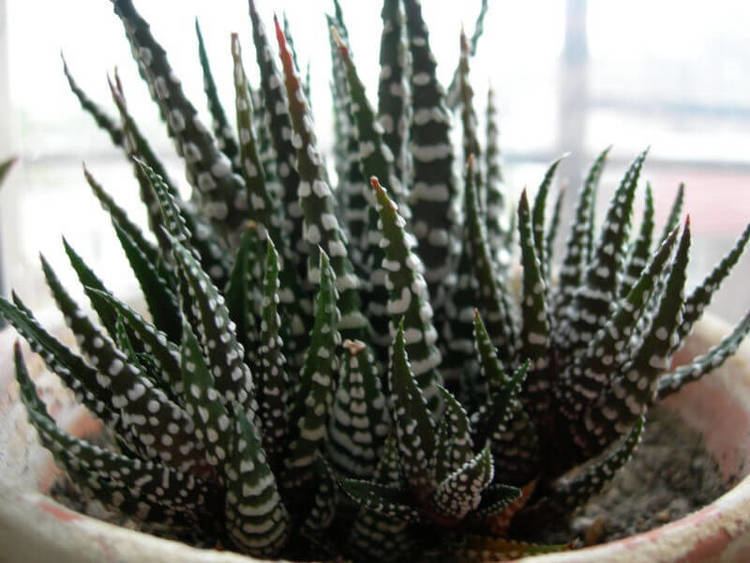Scientific name Haworthia Rank Genus | ||
Lower classifications Haworthia cooperi, Haworthia truncata, Haworthia fasciata, Haworthia limifolia | ||
My plant collection rare succulents variegated haworthia truncata gasteria more
Haworthia is a large genus of small succulent plants endemic to Southern Africa (Mozambique, Namibia, Lesotho, Swaziland, South Africa).
Contents
- My plant collection rare succulents variegated haworthia truncata gasteria more
- My rare haworthia mirror ball succulent is offsetting
- Description and characteristics
- Distribution
- Naming and taxonomy
- Subdivisions
- Species
- Cultivation
- Coarctatae
- Trifariae
- Venosae
- References

Like the aloes, they are members of the subfamily Asphodeloideae and they generally resemble miniature aloes, except in their flowers, which are distinctive in appearance. Horticulturally they are popular garden and container plants.

My rare haworthia mirror ball succulent is offsetting
Description and characteristics

Haworthias are small succulent plants, forming rosettes of leaves from 3 cm (1.2 in) to exceptionally 30 cm (12 in) in diameter, depending on the species. These rosettes are usually stemless but in some species stems reach up to 50 cm (20 in). The inflorescences of some species may exceed 40 cm (16 in) in height. The plants can grow solitary or can be clump-forming. Most species have firm, tough, fleshy leaves, usually dark green in color, whereas others are softer and contain leaf windows with translucent panels through which sunlight can reach internal photosynthetic tissues. Their flowers are small, white and very similar between species. But their leaves show wide variations even within one species.
Distribution
Most species are endemic to South Africa, with the greatest species diversity occurring in the south-Western Cape. Some species do however extend into neighbouring territories, in Swaziland, southern Namibia and southern Mozambique (Maputaland).
Naming and taxonomy

Haworthia is a genus within the family Asphodelaceae, subfamily Asphodeloideae. The genus is named after the botanist Adrian Hardy Haworth. B. Bayer recognized approximately 60 species in a review of the genus in 2012, whereas other taxonomists are very much less conservative. Related genera are Aloe, Gasteria and Astroloba and intergeneric hybrids are known.
Subdivisions

The classification of the flowering plant subfamily Asphodeloideae is weak, and concepts of the genera are not well substantiated. Haworthia is similarly a weakly contrived genus. Because of their horticultural interest, its taxonomy has been dominated by amateur collectors, and the literature is rife with misunderstanding of what the taxa actually are or should be. Currently, this relatively loose genus is subdivided into three very distinct groups, traditionally labelled as sub-genera:
Recent phylogenetic studies have demonstrated that the three sub-genera are actually relatively unrelated (Hexangulares was shown to be a sister-group of genus Gasteria, Robustipedunculares more closely related to genus Astroloba, and Haworthia as an out-group related to Aloe). In recognition of the polyphyletic nature of the genus, it has been proposed that Hexangulares and Robustipedunculares be moved into new separate genera ("Haworthiopsis" and "Tulista" respectively).
Botanists had long noticed differences in the flowers the three sub-genera, but had previously considered those differences to be inconsequential, although the differences between species in the same subgenus definitely are. The roots, leaves and rosettes do demonstrate some generic differences while wide variations occur even within one species.
Species
There are about 151 accepted species of Haworthia listed in The Plant List site [1] produced in collaboration between the Royal Botanic Gardens, Kew and Missouri Botanical Garden. However, the actual number and identification of the species is not established; there are over forty species listed as "unresolved" for lack of sufficient information, and the full list reflects the difficulties of Haworthia taxonomy; it includes varieties and Synonyms to a total of 966, even though it excludes various garden hybrids and cultivars. The following list includes only the fully accepted species in the Plant List.
Cultivation
There is widespread special collector interest, and some species such as Haworthia attenuata and Haworthia cymbiformis, are fairly common house and garden plants.
Almost all Haworthia species are naturally adapted for semi-shade conditions (in habitat they tend to grow under bushes or rock overhands) and they are therefore healthiest in shade or semi-shade. Some species like Haworthia pumila and Haworthia truncata can be adapted to tolerate full-sun however.
All Haworthia species favour extremely well-drained soil (in habitat they tend to grow in poor sands, in rocky areas). Watering depends on the species (winter or summer rainfall) but most of the common species are tolerant of a variety of watering routines. Rarer species may have more specific requirements.
Haworthia species reproduce both through seed and through budding, or offsets. Certain species or clones may be more successful or rapid in offset production, and these pups are easily removed to yield new plants once a substantial root system has developed on the offshoot. Less reliably, the plants may also be propagated through leaf cuttings, and in some instances, through tissue culture.
Coarctatae
Stemmed (caulescent) species:
Trifariae
Species with a three-way ("trifarious") leaf arrangement
Venosae
Species with splayed leaves bearing vein-markings ("venose") on the upper leaf surface
